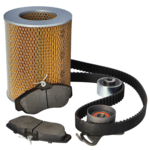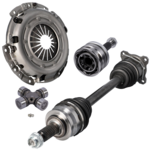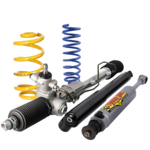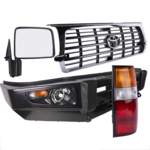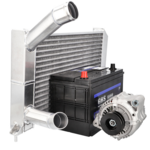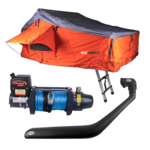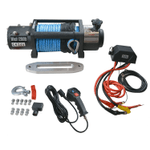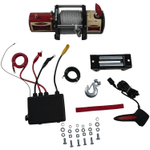What is a winch?
In the 4x4 world, the winch is a device intended to pull a load as opposed to a hoist which is designed to lift a load. The winch features a steel cable or synthetic rope that wraps around a horizontal cylinder, called a drum. This is operated with or without gear reduction and powered by an electric or hydraulic motor.
Why install a winch on your 4x4?
The winch is especially practical when off-roading on your own. It allows you to get out of very embarrassing situations when you're tackling boggy mud, ruts, fords, etc ...
It can also help you clear a fallen tree or even a rock that is blocking your path.
If you are traveling with in a group with other 4x4s, it is always a good idea to have at least one 4x4 equipped with a winch.
Where do you install the winch?
Normally, a winch is fixed to the front of the vehicle, either onto a winch plate that you fix to the chassis behind the original factory bumper, or directly on a reinforced winch bumper designed specifically for this purpose.
For certain extreme 4x4 competitions, a second winch is installed at the rear and / or in a central position to help guide the vehicle through the zones and obstacles.
How to choose?
There is a wide of choice of winches on the market which can be confusing when it comes to choosing the right winch for you and your 4x4. It's important to take into consideration your exact requirements before making your choice.
We've prepared this article as a quick guide to help you make the best choice.

WINCH CAPACITY
One of the most important things to consider when choosing a winch is its maximum winching capacity which is very often described in pounds (lbs).
The pound is a unit of mass equivalent to approximately 0.45 kilograms. So a 12,000 lbs winch has a winching capacity of 5.4 tonnes: 12,000 x 0.45 = 5,400 kg.
This optimum winch capacity is obtained by the first or innermost layer of cable or rope wound onto the winch drum (the one which is closest to the axis of the drum). When the cable is fully wound, it can have 4 or 5 layers of cable. The first layer has the best traction capacity, while the top or outer layer has the best speed ratio.
5.4T Winch capacity example
Length of winch line Winch capacity
Layer 1: 28 meters 5.4 T
Layer 2: 19.5 meters 4.2 T
Layer 3: 12 meters 3.6 T
Layer 4: 5.5 meters 3.1 T
Generally speaking, the rule is to take the weight of your vehicle and multiply it by 2 to obtain the required minimum traction capacity of the winch to be installed.
TYPES OF WINCH GEARING
Straight gear
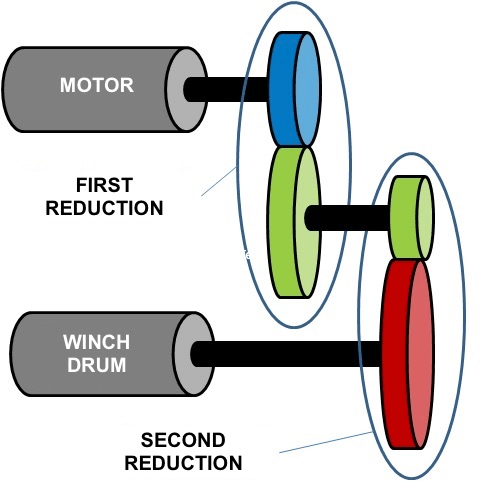
This type of winch uses spur gears (straight cut teeth). This works on the same principle as the transfer case on your 4x4 and offers a fairly fast winding speed.
On the other hand, this design requires an automatic brake and a reasonably powerful engine.
Planetary gears
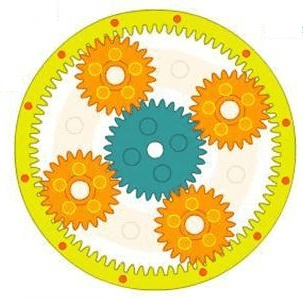
The planetary gear is a power transmission system comprising two planetary gears between which rotate several satellite gears. This type of gearing is often used to reduce a speed of rotation because of the large reduction ratios that thus set-up permits. This system is popular because of its compact size.
Worm gear

This type of gearing allows a significant reduction ratio but its main advantage lies in its small size. However it is not effective in terms of performance.
HYDRAULIC OR ELECTRIC WINCH

An hydraulic winch is powered by the vehicle's power steering pump or by an additional pump.
The most important feature is its long life cycle. You can use a hydraulic winch all day without any risk of overheating.
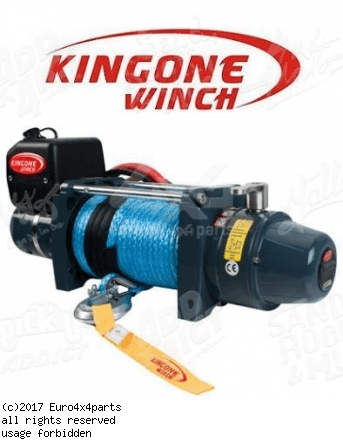
An electric winch performs well during the first few minutes of use at full power. It is easier to install and much cheaper.
Which motor?

If you will be doing plenty of intensive winch work then a hydraulic model will be the best solution.
For occasional use, an electric winch is perfectly good.
Synchronous motors consist of a rotating part: the rotor, and a fixed part: the stator (see below).

The rotor of an electric motor can consist of permanent magnets (Permanent Magnet or PM) which are generally installed on budget winches. They are capable of "pulling" 10 to 15% less than wound motors of the same capacity.
For occasional or use, permanent magnet motors are a popular choice.
For heavier more intensive winch work, wound rotor motors remain the best choice.
WINCH SPEED
Winding speed is a question of patience. Tests show you really get to appreciate the actual winding speed when your are actually winching a load
Many winches are extremely fast when empty but very slow when pulling the vehicle.
The majority of winches have a speed which is 1 to 1.5 meters per minute when loaded.
It's up to you to determine your level of patience when you wind up your winch cable. But above all keep in mind that a winch that is fast to wind under load is also a big consumer of electrical energy.
To have a fast winch that has a large load-carrying capacity, you need a powerful motor.
CABLE OR ROPE?
You have two basic choices: steel cable or synthetic rope.
Both will do the job and each has it's own advantages and disadvantages.

Steel cable is the traditional choice. It is made of strands of carbon steel wire, usually 7 packs of 19 strands (7x19).
Benefits:
- steel cable is much more resistant to abrasion than synthetic rope
- highly heat resistant
- relatively inexpensive
Disadvantages:
- it is vulnerable to crushing when pinching during winding
- it is relatively heavy, weighing around 18 kg with a hook
- it can store large amounts of kinetic energy and can whip with a deadly effect if it becomes detached or breaks
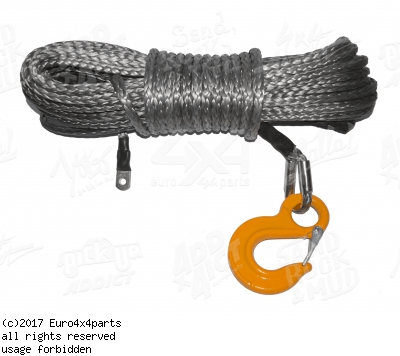
Synthetic cord is the more recent design.
Benefits:
- synthetic rope is very light, a length of 28 meters with its hook weighs only about 3 kg
- accidents caused by a rope are much rarer
- it floats
- in an emergency, you can make a knot to help out
Disadvantages:
- more sensitive to friction than the "steel" cable
- more expensive
For occasional winch use or novice users, the synthetic rope is often the right choice because it is easier to use.
For heavy work, the steel cable remains the best choice.
THE RIGHT LENGTH?
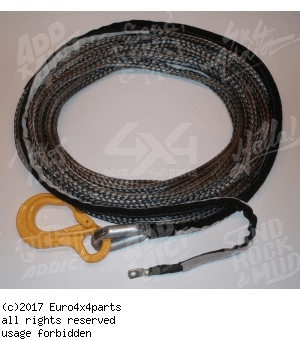
Having a long length of cable or rope on the drum of your winch means you can find a suitable winch point further from your 4x4. But this is not always an advantage.
As you now know, the maximum traction of your winch achieved on the first layer of the drum. So to get maximum traction, you have to unroll the whole cable or rope.
The other consideration to take into account is that the more cable or rope you have wound up on the drum, greater the chance that it may get stuck or even twist and deteriorate.
This is why seasoned users often prefer to have less cable or rope length, and to add a strap if necessary. This can prove to be a simple and practical solution.
PARTS
Best budget choice: Equip'addict winches
We offer a range of winches from 3.6 to 7.7 tonnes in 12 volts or 24 volts supplied complete with steel cable or synthetic rope. These represent great value for money for occasional use and will help you to get out of trouble when the going gets tough. This range even includes a model is UTV / ATV vehicles.
Browse the full range of Equip'addict winches
Top quality: KINGONE winches
We offer a complete range of KingOne 4x4 winches from 3 to 9 tonnes in 12 volts supplied with synthetic rope as standard plus 4 winches designed for UTV / ATV, with 1.4 tonnes and 1.8 tonnes capacity.
Whether its on an overland expedition or in extreme off-roading conditions, they have proved their reputation which is second to none.
A bare hydraulic model is also available.
Browse the full range of KingOne winches
Ultimate winches: GIGGLEPIN
GIGGLEPIN winches need no introduction. The have an unbeatable reputation having been featured in so many competition wins.
The famous GP100 with the 6.8 HP double Bow II engine is available in 12 volts, supplied with Albright high quality relays and equipped with a pneumatic release system.
In order to choose the required weight / speed ratio, 5 different ratios are proposed: from 3 to 14 tons and between 23 and 100 m/minute.
All models feature a 766 mm wide drum that can handle 40m of 12 mm rope (rope sold separately, as required - enough to cope with the toughest of situations.
Browse the full GIGGLEPIN range
Winch accessories
Do it yourself, you'll be even prouder! To help you out, Euro4x4parts shares its know-how and expertise in mechanics through 4X4XPERT: new products, technical sheets, and personalized tutorials... You've got the keys!
And because we also learn from your experiences, your feedback is essential. Let us know your thoughts and suggestions by email: 4x4xpert@euro4x4parts.com
Check out our complete catalogue of 4x4 parts and accessories!
All the photos in our articles are taken on authorized roads or tracks, private land, or during supervised competitions. Let's all do our part to preserve the environment!
Please note: Euro4x4parts publishes this information to help its customers, but cannot be held responsible for the advice given here and their consequences when used.








